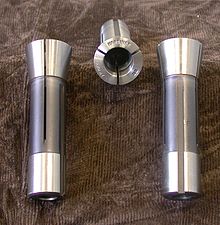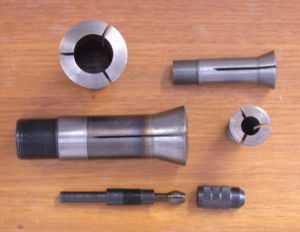- Collet
-
For other uses, see Collet (disambiguation).
A collet (
 /ˈkɒlɨt/) is a holding device—specifically, a subtype of chuck—that forms a collar around the object to be held and exerts a strong clamping force on the object when it is tightened, usually via a tapered outer collar. It may be used to hold a workpiece or a tool.
/ˈkɒlɨt/) is a holding device—specifically, a subtype of chuck—that forms a collar around the object to be held and exerts a strong clamping force on the object when it is tightened, usually via a tapered outer collar. It may be used to hold a workpiece or a tool.A collet is a sleeve with a (normally) cylindrical inner surface and a conical outer surface. The collet can be squeezed against a matching taper such that its inner surface contracts to a slightly smaller diameter, squeezing the tool or workpiece whose secure holding is desired. Most often this is achieved with a spring collet, made of spring steel, with one or more kerf cuts along its length to allow it to expand and contract. An alternative collet design is one that has several tapered steel blocks (essentially tapered gauge blocks) held in circular position (like the points of a star, or indeed the jaws of a jawed chuck) by a flexible binding medium (typically synthetic or natural rubber). The Jacobs Rubber-Flex brand is a name that most machinists would recognize for this type of collet chuck system. Regardless of the collet design, the operating principle is the same: squeeze the collet against the tool or workpiece to be held, resulting in high static friction. Under correct conditions, it holds quite securely.
Contents
Nomenclature variations
Generally, a collet chuck, considered as a unit, consists of a tapered receiving sleeve (often integral with the machine spindle), the collet proper (usually made of spring steel), which is inserted into the receiving sleeve, and (often) a cap that screws over the collet, clamping it via another taper.
Usually in shop-floor terminology, the terms collet and chuck are used in contradistinction; users speak of holding a workpiece or tool with either a collet or a chuck. In this context "chuck" means any type of chuck other than a collet chuck (scroll chuck, independent-jaw chuck, etc.).
Advantages and disadvantages compared to other types of chuck
Each collet generally has only a narrow clamping range, which means that a large number of collets are required to hold a given range of materials in the chuck, unlike with many other types of chuck that will generally cover a wide range of sizes. This gives collet chucks the disadvantage of relatively high capital cost.
The collet's advantage over other chucks is that it manages to combine all of the following traits into one chuck, and this combination is highly valuable in an environment of repetitive part production:
- Speed of chucking (unclamp one part, switch to a new part, reclamp)
- Self-centering
- Strong clamping force
- Resistance against being jarred loose (untightened)
- Centering at a high level of precision (runout is less than 0.005 in (0.13 mm) TIR)
Of the above traits, scroll chucks offer always № 1 and № 2; usually № 3; to varying extents № 4 (depending on the situation); but not reliably № 5. Independent-jaw chucks offer always № 3; usually № 4; reliably № 5 (but at the expense of paying a skilled user to spend time achieving it); never № 2; and generally not № 1. Meanwhile, a collet chuck can deliver all 5 reliably, and with no need for a skilled user. (№s 3 to 5 do depend on the object being clamped closely matching the size and shape of the collet's clamping surface. This constraint is usually not a problem when the object is good-quality bar stock; the shank of a non-abused drill bit, reamer, endmill, etc.; or a previously machined part that is being rechucked for additional cutting operations.)
Examples of collet applications in various industries
Woodwork
On a wood router (a hand-held or table-mounted power tool used in woodworking), the collet is what holds the bit in place. In the U.S. it is generally for 0.25 or 0.5 inch (6.3 or 13 mm) bits, while in Europe bits are most commonly 6 or 8 mm (0.24 or 0.31 in). The collet is hexagonal on the outside so it can be tightened or loosened with a standard wrench, and has threads on the inside so it can be screwed on to the motor arbor.
Metalworking
There are hundreds of designs of collet used in the metalworking industry. Common industry-standard designs for manual mills are 5C[1] and R8[2], however most are proprietary designs that only fit one specific manufacturer's equipment. Collets can range in holding capacity from zero to several inches in diameter. The most common type of collet is one that grips a round bar or tool, but there are collets for square, hexagonal, and other shapes. In addition to the outside-holding collets that are so common, there are collets that are used for holding a part on its inside surface so that it can be machined on its outside surface (basically, akin to an expanding mandrel). Furthermore, it is not uncommon for users to make a custom (bespoke) collet to hold any unusual size or shape of part. These are often called emergency collets (e-collets) or soft collets (from the fact that they are bought in a soft (non-hardened) machinable state and cut as needed to fit). Yet another type of collet is a step collet, which steps up to a larger diameter from the spindle (analogous to how a mushroom cap is larger than the stem). Step collets allow the holding of rather large workpieces, as long as they need not pass into the spindle through-hole—for example, disc-shaped workpieces.
In the accompanying photo, the two top left collets are the side and end view of one style of collet; the two right collets are from a smaller range. The lower image is of a disassembled pin chuck that is used to hold small drills or workpieces. The leftmost part is the body, the collet is shown protruding from the body, and the nose cap is separate, on the right.
In use, the part to be held is inserted into the collet, and then the collet is pushed (via a nose cap) or pulled (via a drawbar) fully into the body (which has a taper to match the collet machined into the front). When the nose cap or drawbar is tightened properly, enough force is applied to the collet that the tapers at the front and back of the collet are pushed into their matching tapers, causing the collet to constrict in diameter. This constriction exerts considerable force onto the shank of the workpiece or tool that is being held in the collet. It is then securely held against any forces it may encounter during normal operation.
Craft hobbies
Many users (hobbyists, graphic artists, architects, students, and others) may be familiar with collets as the part of an X-Acto or equivalent knife that holds the blade. Another common example is the collet that holds the bits of a Dremel or equivalent rotary file.
Semiconductor work
In semiconductor industry, a die collet is used for picking a die up from a wafer after die cutting process has finished, and bonding it into a package. Some of them are made with rubber, and use vacuum for picking.
Internal combustion engines
The two halves of the collar which fits around the stem of a valve and traps the spring against the cylinder head are known as split collets.
References
Bibliography
- Hoffman, Edward G. (2004), Jig and fixture design (5th ed.), Cengage Learning, ISBN 9781401811075, http://books.google.com/books?id=6UFhomTE8KYC.
External links
Metalworking Machining and computing Computer-aided engineering Drilling and threading Grinding and lapping Abrasive · Angle grinder · Bench grinder · Coated abrasives · Cylindrical grinder · Diamond plate · Flick grinder · Dresser · Grinding · Grinding machine · Grinding wheel · Jig grinder · Lapping · Sanding · Sharpening stone · Spark testing · Surface grinder · Tool and cutter grinderMachining and milling Electrical discharge machining · Electrochemical machining · Endmill · Engraving · Hobbing · Lathe · Machine tool · Machining · Milling cutter · Milling machine · Planer · Pantograph · ShaperMachine tooling Angle plate · Chuck · Collet · Jig · Fixture · Indexing head · Lathe center · Machine taper · Magnetic base · Mandrel · Rotary table · WigglerTerminology Casting · Fabrication · Forming · Jewellery · Machining · Metallurgy · Smithing · Tools and terminology · Welding Categories:- Lathes
- Machine tools
- Woodworking clamps
Wikimedia Foundation. 2010.


